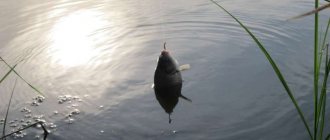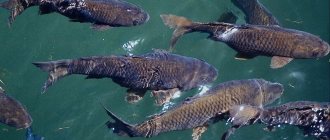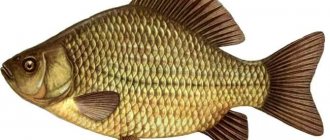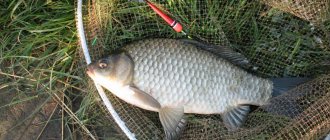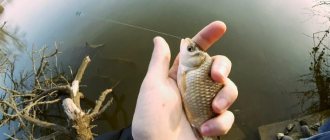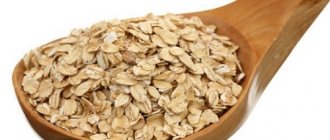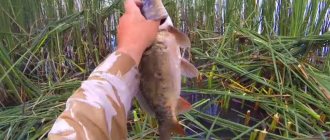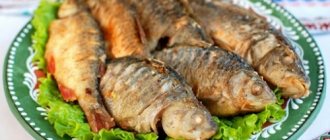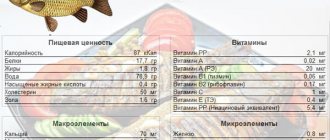When does crucian carp go to spawn?
Despite the above-described features of crucian carp spawn, whatever one may say, spawning is closely related to water temperature. Referring to various sources, we can say that the optimal temperature should be from 13 to 18 degrees. In shallow water, where the water warms up better, spawning occurs faster.
At depth, spawning of crucian carp occurs in several stages. The fish gradually moves from the shore to the heart of the reservoir. Due to the long process of spawning, the ban on catching crucian carp is being postponed. The first wave of spawning may occur at the end of May, and the second in mid-summer.
Female crucian carp have their own characteristics. For example, during spawning, she can join a school of tench, which are not able to fertilize crucian carp, but successfully help in the development of future fry.
Before going to spawn, crucian carp form in schools. If the reservoir is not large, herds may include specimens of different sizes. The spawning area is always noisy, with fish constantly jumping out of the water.
When does spawning of crucian carp begin and what is special about this period?
For crucian carp, the time of spawning is also influenced by its main habitat in the reservoir.
For example, crucian carp living near the shore spawns earlier than crucian carp living in the middle of the reservoir. This feature is due to the fact that with the onset of spring the lake begins to defrost gradually. And, consequently, the aquatic environment warms up much earlier near the shore, creating favorable conditions for the spawning of crucian carp. The development of crucian carp eggs also depends on the temperature of the surrounding aquatic environment. For normal development of eggs, the temperature in the reservoir must be at least 13-14 0 C. If the spawning site is located in an aquatic environment below 13 0 C near springs, then the chance of fry appearing is reduced to a minimum, or even zero.
The spawning rate also depends on the temperature of the reservoir. The higher the temperature, the faster the crucian carp complete their mating games. Females usually lay eggs at sunrise, grouping with male crucian carp. Basically, females lay eggs on algae or on plant stems. The color of crucian carp eggs is yellow. In some cases, females can delay spawning until mid-June, laying eggs several times.
The spawning process of crucian carp is in many ways similar to the spawning of other fish. When spawning, he forgets about food and is completely devoted to the responsible task of procreation. However, crucian carp spawning also has a number of features:
- In many reservoirs, this fish spawns only in early summer. However, in some lakes and ponds it can lay eggs throughout the entire period of open water until October-November. So don’t be surprised if in the fall you catch a crucian carp full of caviar.
- Silver crucian carp, which is most common in our reservoirs, mainly consists of females. But this does not stop him from reproducing. Such crucian carp goes to spawn with other species of fish - carp, tench, rudd and even gudgeon, the males of which do not fertilize the eggs, but only stimulate their further development.
During spawning, crucian carp is located close to the shore; you can especially often find it near the reeds
During spawning, fish gather in small schools and rub noisily against reeds, snags, bushes and branches in the water. At this time, the crucian carp forgets about its former caution. He may be so close to the shore that he is forced to swim sideways.
Often, after fishing, when you pull out the pokes (rod stands) that were installed only half a meter from the shore, you can see that they are all covered with caviar. During the spawning period, crucian carp is not afraid of anything - neither people on the shore nor birds of prey scare it. Some fishermen even pick up a landing net and rush to catch emboldened fish with it. But this is very reminiscent of poaching.
One of the most common peaceful fish in our reservoirs is crucian carp. Fishing for it is very unpredictable, but interesting and even exciting. To determine in what period it will be most effective, it is worth learning more about the biological characteristics of this fish and their influence on its behavior. In particular, we will consider when the spawning of crucian carp begins and ends, and how this process affects the bite of this representative of cyprinids.
One of the most common peaceful fish in our reservoirs is crucian carp. Fishing for it is very unpredictable, but interesting and even exciting.
To determine in what period it will be most effective, it is worth learning more about the biological characteristics of this fish and their influence on its behavior.
In particular, we will consider when the spawning of crucian carp begins and ends, and how this process affects the bite of this representative of cyprinids.
Spawning of crucian carp in central Russia
In central Russia, crucian carp spawning begins only in late spring, usually in the second ten days of May. Spawning lasts about 30 days. In the southern regions, fish go to spawning grounds in early May, and in the north, it happens in June.
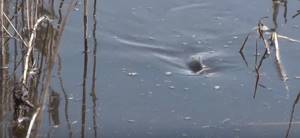
Note that in reservoirs with abundant vegetation, spawning occurs later than in reservoirs with open water. The fact is that bogs most often become completely free of ice only in June. Deep-water rivers may not warm up to the required temperature for a long time. In shallow water, crucian carp spawn much faster than in a large body of water.
Fishing during spawning
Catching crucian carp during spawning, as a rule, does not bring the expected results. The fish is so engrossed in the game that it practically does not feed. Even in the shallows, where the depth of the water allows it to move only on its side, crucian carp rarely becomes interested in the bait offered to it.
But, using some tricks, ordinary float equipment, an elastic band or a feeder, you can ensure success. To do this, you need to know the peculiarities of fish behavior during spawning:
- You need to fish in deep water, where crucian carp spawn in several stages.
- If in shallow water the fish have already begun to spawn, you need to cast the tackle a little deeper, where larger individuals are just beginning to gather to play. They are not yet in the mood for fertilization, which means they may well be interested in the bait.
- On a familiar body of water, determine the location of the deep drop (a distance of at least 5 m from the shore). At the transitions from shallow water to pits, crucian carp waits for the spawning period.
- Use caddisfly larvae, bloodworms or maggots as bait, and steamed pearl barley or flavored dough for bait.
Crucian carp is one of the few fish that often does not have time to restore its protein needs after winter, so bloodworms are considered the best spring bait for a float tackle or feeder.
When catching crucian carp during spawning, special attention should be paid to the time of day. The game begins when the sun is already bright enough, and the air temperature rises several degrees compared to the night. For example, in central Russia this period occurs at 8-10 o’clock in the morning, and therefore for morning fishing you need to hurry up to sunrise or transfer fishing to the daytime hours.
If underwater vegetation has not yet developed enough, try using fishing elastic for fishing. The tackle is made in the following way:
- Rubber from 5 to 15 meters long is tied to a rope with a load.
- 5-6 leashes (up to 30 cm long) are attached to a five-meter piece of fishing line.
- Using a carabiner, the equipment is secured through the winding rings to an elastic band, and then to the fishing line on the spinning rod.
For fishing to be effective, 8-10 meters of rubber and a load weighing 350-400 grams are enough. For bait, use a moving earthworm. It happens that attempts to catch crucian carp during spawning do not end in anything. There is no need to despair. You need to wait a few weeks and go fishing after spawning, when the fish begin to actively bite, restoring strength after the mating season.
Photo 3. A flock of crucian carp during spawning.
Where do crucian carp spawn?
As the mating season approaches, the time comes to choose a place to raise future offspring. The choice remains with the female, who will be followed by a retinue of males.
It is not typical for crucian carp to leave their habitual place in search of spawning grounds. For such an important task, the crucian carp will choose a well-warmed place with vegetation, on which the female will attach the eggs. It is preferable if the bottom is muddy. In rivers, flow should be minimal or completely absent.
Crucian carp with mature eggs can be found in open water throughout the spring and summer.
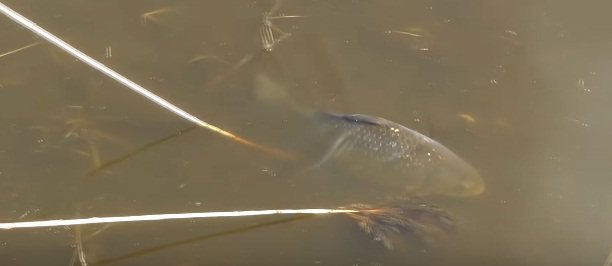
Crucian carp is a prolific fish, ready to lay up to 300,000 eggs at a time. The higher the water temperature, the faster the eggs will develop. The larva develops within a month, being attached to algae. In 4 weeks, the formation of fins, tail and scales occurs. But, since there are enough predators in reservoirs ready to feast on fresh caviar, the survival rate of crucian carp is not too high.
Culinary recipes for preparing crucian caviar
When removing caviar from the belly of the fish, you need to act carefully, trying not to crush the gall bladder. In the simplest versions (frying, baking), crucian carp caviar is used in its natural form, without peeling the film.
To prepare a punchy lightly salted appetizer, separate the egg using a fork, scraping off the eggs from it. For large volumes of processing, caviar bags are ground on a sieve with a mesh size of 2-3 mm. Small grains pass through the mesh, and the films remain on top. The punch mixture can also be used to make pancakes or cutlets.
Fried caviar
You can prepare crucian caviar in the simplest way. Lightly salt and pepper the removed eggs with eggs and leave for 20-30 minutes. For breading, use only flour or combine it with lezon (lightly beaten egg). For frying, use vegetable or butter ghee; it must be well heated.
The salted pieces are rolled in flour and, if desired, dipped in a beaten egg. Immediately place in oil heated in a frying pan and fry until the color changes along the contour of the piece (a golden, orange tint appears). The caviar is turned over to the other side and fried a little more until a crust is obtained. Can be served hot or cold.
Baking
For baking in the oven, prepare the pieces as for frying. Grease the frying pan with oil, lay out the caviar bags (500 g), you can first roll them in flour. Then place 5-6 tbsp on top of the layer. l. fat sour cream and distribute it over the fish by-product. Place in the preheated oven and bake for about 20 minutes. Serve with a side dish of potatoes.
Another baking option involves using the caviar mass separated from the crust. Take 500 g of crucian caviar and combine it with soaked white bread (250 g). Chop and lightly fry the onion (250 g), combine it with the minced meat. Add 80-100 g of sour cream or cream, 1 chicken yolk and mix the mixture. Place it in portioned pots or small molds and bake for 40 minutes at +200°C.
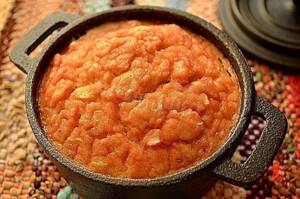
Cutlets and pancakes
For such dishes, the caviar bags need to be mashed with a fork until smooth. The cutlet mass is prepared with the addition of various ingredients: finely chopped sauerkraut, grated carrots, raw potatoes, etc. In each case, the result is a dish with an original taste. But for simple crucian caviar cutlets you will need:
- 500 g caviar mass;
- 150 g onions (you can take green ones);
- 2-3 tbsp. l. chopped seasonal greens;
- 1 egg;
- salt, pepper to taste.
Mix caviar, semolina and egg into the minced meat, add chopped onion and seasonings. Knead the mixture well and form it into cutlets. Fry in hot oil until golden brown. Serve with any side dish and sauce intended for fish.
The process of preparing pancakes consists of mixing 250 g of caviar, 1-2 chicken eggs, seasonings to taste and a small amount of flour (wheat, buckwheat, oatmeal). The dough is kneaded to the consistency of sour cream. The oil is preheated and 1 tbsp is poured onto it. l. test. Fry the pancakes until golden brown, turn them over to the other side and cook until done. Crucian carp caviar, which is quite high in calories, allows you to make these pancakes a hearty and quick breakfast.
Read: What kind of product is black caviar: what fish is it obtained from, beneficial properties
Pickling
The punchy lightly salted appetizer is prepared only from fresh product. The eggs of the caught crucian carp are removed, the caviar mass is separated from the films and salted to taste, mixing the eggs with table salt. Leave for 3-5 hours, add a little vegetable oil and serve with lemon slices, fresh butter and bread.
At what age does crucian carp spawn?
Silver predators are considered early maturing. Crucian carp are ready to produce their own kind already at the age of 2-3 years. But his golden ones are lagging behind somewhat - a year or two. In fact, the rate of sexual maturity is influenced by the food supply of the reservoir and weather conditions. In ponds with poor food supply, the time for spawning occurs at a later age.
Physically, the fish is ready to throw, having reached a length of at least 10 cm and a weight of at least 100 grams. The female is usually larger than the male.
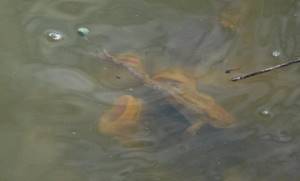
How long does it take for crucian carp to recover after spawning?
Like other members of the carp family, crucian carp need time to recover after spawning. This period takes from 3-4 to 10 days. Small crucian carp, weighing up to 500 grams, do not get sick after spawning for as long as large individuals. It lays fewer eggs and thus finishes spawning earlier, moving to deeper areas where it “rests” for several days.
After spawning, crucian carp need time to rest, for which they go deeper
Good sunny weather also helps the fish recover faster after mating games. Rains and cold weather, on the contrary, negatively affect the process of adaptation of fish to life after spawning. Again, the size of the reservoir also affects. On small ponds and rivers, crucian carp are sick for no more than 3-4 days. On large lakes and reservoirs he will need twice as much time to rest.
Prohibitions during spawning of crucian carp
During the spawning process, the fish are unlikely to be actively interested in food. You can catch trophies if you go fishing before or after spawning. When going for trophies to your favorite body of water in the spring, it is worth remembering that unlimited fishing can cause serious harm to the population.
Spawning restrictions are different for each region. To avoid financial penalties, it is worth studying the rules for catching crucian carp in your area every year.
During the spawning period, crucian carp can be caught exclusively with passive baits using bottom or float rods. It is forbidden to use a double or triple hook. The boat is also prohibited. Also, to avoid a fine, you should not go far into the water.
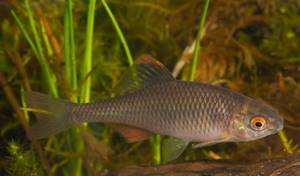
Spawning grounds are strictly prohibited, as crucian carp spawn for a long time, sometimes in tandem with valuable species of underwater inhabitants.
In general, the crucian carp population does not cause concern. Caviar develops well, both in natural and artificial conditions. However, this should not be a reason for indiscriminate fishing. After all, in addition to humans, future crucian carp have plenty of enemies in reservoirs.
How to understand that crucian carp has begun spawning
This is quite easy to do. Firstly, if you fish in the same body of water, then it’s enough to remember when spawning begins there. As a rule, from year to year it takes place at the same time with a difference of several days, which depends on the weather and the early or late arrival of spring.
A fisherman can understand that a crucian carp is spawning by seeing a fish swimming near the shore on its side
Secondly, pay attention to the water temperature. Most online resources that provide weather forecasts also contain information about the average water temperature in your region. If it fluctuates around 15-17°C, then most likely the fish has now left for spawning or is “sick” after it.
By arriving directly at the reservoir, you can also quickly understand whether the crucian carp has begun spawning. If movements are noticeable in the coastal vegetation, sounds similar to slurping are heard, then we can say with confidence that it is spawning.
Crucian carp spawns in the fourth or fifth year of life. When crucian carp begin to spawn, there is almost no bite.
Despite the above-described features of crucian carp spawn, whatever one may say, spawning is closely related to water temperature. Referring to various sources, we can say that the optimal temperature should be from 13 to 18 degrees. In shallow water, where the water warms up better, spawning occurs faster.
At depth, spawning of crucian carp occurs in several stages. The fish gradually moves from the shore to the heart of the reservoir. Due to the long process of spawning, the ban on catching crucian carp is being postponed. The first wave of spawning may occur at the end of May, and the second in mid-summer.
Female crucian carp have their own characteristics. For example, during spawning, she can join a school of tench, which are not able to fertilize crucian carp, but successfully help in the development of future fry.
We suggest you read: Optimal pressure for carp fishing The best weather and time for carp fishing
Before going to spawn, crucian carp form in schools. If the reservoir is not large, herds may include specimens of different sizes. The spawning area is always noisy, with fish constantly jumping out of the water.
In central Russia, crucian carp spawning begins only in late spring, usually in the second ten days of May. Spawning lasts about 30 days. In the southern regions, fish go to spawning grounds in early May, and in the north, it happens in June.
Note that in reservoirs with abundant vegetation, spawning occurs later than in reservoirs with open water. The fact is that bogs most often become completely free of ice only in June. Deep-water rivers may not warm up to the required temperature for a long time. In shallow water, crucian carp spawn much faster than in a large body of water.
As the mating season approaches, the time comes to choose a place to raise future offspring. The choice remains with the female, who will be followed by a retinue of males.
It is not typical for crucian carp to leave their habitual place in search of spawning grounds. For such an important task, the crucian carp will choose a well-warmed place with vegetation, on which the female will attach the eggs. It is preferable if the bottom is muddy. In rivers, flow should be minimal or completely absent.
Crucian carp with mature eggs can be found in open water throughout the spring and summer.
Crucian carp is a prolific fish, ready to lay up to 300,000 eggs at a time. The higher the water temperature, the faster the eggs will develop. The larva develops within a month, being attached to algae. In 4 weeks, the formation of fins, tail and scales occurs. But, since there are enough predators in reservoirs ready to feast on fresh caviar, the survival rate of crucian carp is not too high.
Since crucian carp are accustomed to spawning in several stages at intervals (the first wave can begin in the spring, and subsequent waves in the summer), it is believed that the fish spawns several times a year.
Silver predators are considered early maturing. Crucian carp are ready to produce their own kind already at the age of 2-3 years. But his golden ones are lagging behind somewhat - a year or two. In fact, the rate of sexual maturity is influenced by the food supply of the reservoir and weather conditions. In ponds with poor food supply, the time for spawning occurs at a later age.
Physically, the fish is ready to throw, having reached a length of at least 10 cm and a weight of at least 100 grams. The female is usually larger than the male.
During the spawning process, the fish are unlikely to be actively interested in food. You can catch trophies if you go fishing before or after spawning. When going for trophies to your favorite body of water in the spring, it is worth remembering that unlimited fishing can cause serious harm to the population.
Spawning restrictions are different for each region. To avoid financial penalties, it is worth studying the rules for catching crucian carp in your area every year.
During the spawning period, crucian carp can be caught exclusively with passive baits using bottom or float rods. It is forbidden to use a double or triple hook. The boat is also prohibited. Also, to avoid a fine, you should not go far into the water.
In general, the crucian carp population does not cause concern. Caviar develops well, both in natural and artificial conditions. However, this should not be a reason for indiscriminate fishing. After all, in addition to humans, future crucian carp have plenty of enemies in reservoirs.
After an important task, the crucian carp resumes its usual habits and returns to its usual habitats for food. Each region has its own peculiarities of fishing. The zhor will be affected by wind speed, precipitation, and water temperature.
In the first summer month, the reservoirs are full of vegetation, so the crucian carp has enough natural food. In subsequent months, the fish will react to earthworms, bloodworms, and maggots. Bread, flakes or cake are also suitable as bait.
If after spawning the fish are in no hurry to bite, you shouldn’t expect a miracle. Try to experiment with baits.
Many people have heard that the spawning period of crucian carp coincides with the flowering of viburnum. We hasten to inform you that the popular belief is not true, especially for the middle latitudes of our country.
Experienced fishermen know that crucian carp can be both gold and silver. The latter are more numerous. The number of silver inhabitants increases, since the females are triploid, that is, the eggs are able to be fertilized without the participation of males.
Let's tell you a few secrets about catching crucian carp.
- Fish in large bodies of water where females spawn in several stages.
- In small bodies of water, if the crucian carp has already started spawning, cast the fishing rod deeper, where large specimens “wander.”
- Live bait, worms, bloodworms, and maggots work best as bait. Bloodworms, by the way, will be a delicious source of protein, which crucian carp so lacked during spawning.
When does crucian carp start biting after spawning?
After an important task, the crucian carp resumes its usual habits and returns to its usual habitats for food. Each region has its own peculiarities of fishing. The zhor will be affected by wind speed, precipitation, and water temperature.
In the first summer month, the reservoirs are full of vegetation, so the crucian carp has enough natural food. In subsequent months, the fish will react to earthworms, bloodworms, and maggots. Bread, flakes or cake are also suitable as bait.
During the post-spawning period, crucian carp may behave unpredictably, either abruptly grabbing the prey or slowly savoring it. The peak of the bite will be in the morning from 6 to 10 am. The exception will be windy, gloomy days.
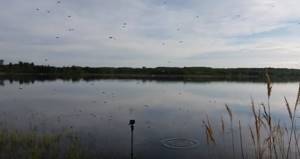
If after spawning the fish are in no hurry to bite, you shouldn’t expect a miracle. Try to experiment with baits.
Fishing for crucian carp and spawning
Most fishermen agree that catching crucian carp during spawning is a stupid activity. You can, of course, find cases on the Internet where people managed to achieve success during this important period in the life of a crucian carp, but this is rather an exception to the rule, which proves the existence of the rule itself.
However, this should not discourage you from trying on your own. In general, spawning fishing is reminiscent of a lottery, not a sport , because success depends not on preparation, selected bait and other factors, but mainly on the luck of the fisherman that day.
Tips from Velesovik
Many people have heard that the spawning period of crucian carp coincides with the flowering of viburnum. We hasten to inform you that the popular belief is not true, especially for the middle latitudes of our country.
Experienced fishermen know that crucian carp can be both gold and silver. The latter are more numerous. The number of silver inhabitants increases, since the females are triploid, that is, the eggs are able to be fertilized without the participation of males.
Let's tell you a few secrets about catching crucian carp.
- Fish in large bodies of water where females spawn in several stages.
- In small bodies of water, if the crucian carp has already started spawning, cast the fishing rod deeper, where large specimens “wander.”
- Live bait, worms, bloodworms, and maggots work best as bait. Bloodworms, by the way, will be a delicious source of protein, which crucian carp so lacked during spawning.
Fishing during spawning
Catching crucian carp during the natural breeding process is quite difficult. They cease to be interested in profit and do not get food. Another obstacle to fishing is the inaccessibility of these inhabitants of the aquatic fauna, because for the entire spawning period the fish swim to quiet places that are invisible to human eyes. Nature lovers can watch a fascinating spectacle - mating games.
Experienced fishermen and environmentalists do not recommend fishing at this time, not only because fishing is virtually impossible during the spawning season.
The increase in the population of crucian carp is a natural process created by nature. To compensate for the damage to the fauna caused by humans, all living things must reproduce. The various tricks that some fishermen go to in order to get a trophy even during spawning reduce the fish population. Article on the topic: Crucian carp killer

